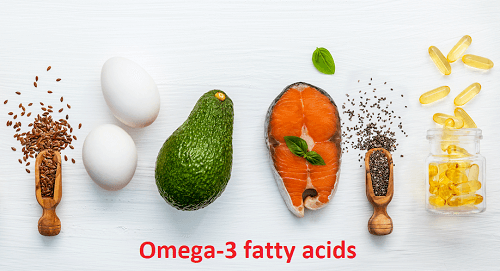Omega 3 Fatty AcidsOmega-3 fatty acids are polyunsaturated fatty acids. They have a double bond at the third carbon from the end of the carbon chain. The three main omega-3 fatty acids are alpha-linolenic acid (ALA), eicosapentaenoic acid (EPA), and docosahexaenoic acid (DHA). They are also known as omega-3 fats. 
ALA is mostly found in plant oils such as soybean, canola and flaxseed oil. Whereas, DHA and EPA are found in fish and other seafood. They are considered essential fats as our body cannot prepare them and we have to get them from food. DHA is high in the amount in the retina (eye), brain, and sperm cells. They are metabolised and oxidized in the liver. Why are omega 3 fatty acids important?These fatty acids are an important part of cell membranes in our body. They play an important role in the functioning of cell receptors in the cell membranes. For example, they help in the formation of hormones that control clotting of blood, movement of artery walls and inflammation. They also bind to receptors of cells that take part in the regulation of genetic functions. So, they are found effective in preventing heart disease and stroke. Health Benefits of Omega-3 Fatty AcidsReduces blood fat (triglycerides): These fatty acids, particularly found in fish oil, can lower high triglyceride levels. Thus, it helps prevent the risk of stroke and heart diseases. Reduce stiffness and joint pain: EPA and DHA help treat stiffness and pain in joints. They also seem to improve the efficacy of anti-inflammatory drugs. Alleviates depression: They may also help reduce and prevent depression. However, EPA is believed to be the most effective at preventing depression. Baby growth: DHA seems to provide visual and neurological health benefits to babies. Prevents Asthma: They lower inflammation, a major reason for asthma in most people. ADHD: As per some studies, omega-3 fatty acids can reduce the symptoms of ADHD (attention deficit hyperactivity disorder) in children and can help improve their mental skills like thinking, memory, learning, etc. Alzheimer's disease and dementia: It has been found in some research that omega-3 helps prevent Alzheimer's disease and dementia and may reduce the gradual memory loss due to ageing. Autoimmune diseases: They helps fight various autoimmune disorders like type 1 diabetes, rheumatoid arthritis, psoriasis, etc. Prevent cancer: They also help prevent cancer as suggested by some research. Their intake can reduce the chances of colon, prostate and breast cancer. Reduce Liver fat: It helps treat non-alcoholic fatty liver disease (NAFLD) by reducing liver fat caused by NAFLD. Healthy skin: They help keep skin healthy by preventing premature aging, protecting from sun damage, reducing the risk of acne. Eye health: DHA is a structural component of the eye retina. So, they reduce the risk of macular degeneration, a major cause of eye damage. Omega-3 Fatty Acids FoodsLots of foods provide these fatty acids, some of which that are high in omega-3 are listed below:
Next TopicOxalic Acid
|
 For Videos Join Our Youtube Channel: Join Now
For Videos Join Our Youtube Channel: Join Now
Feedback
- Send your Feedback to [email protected]
Help Others, Please Share









